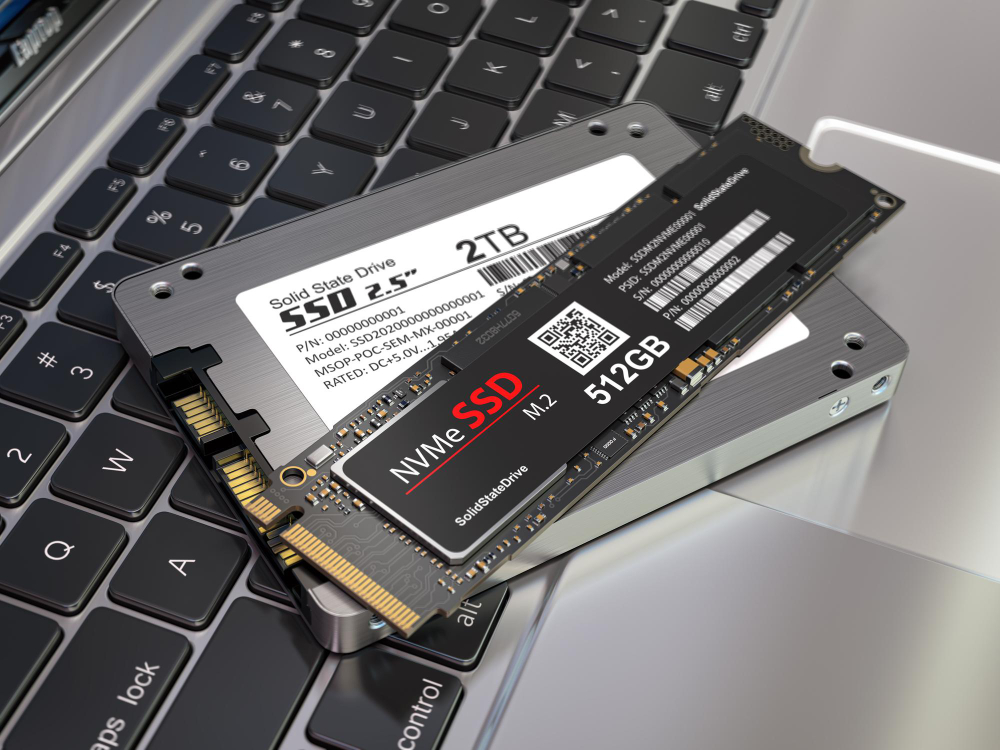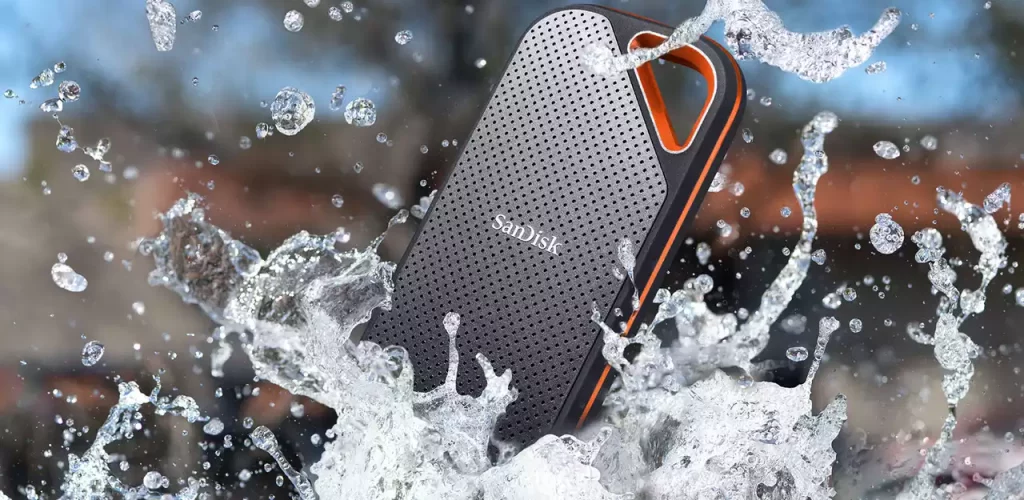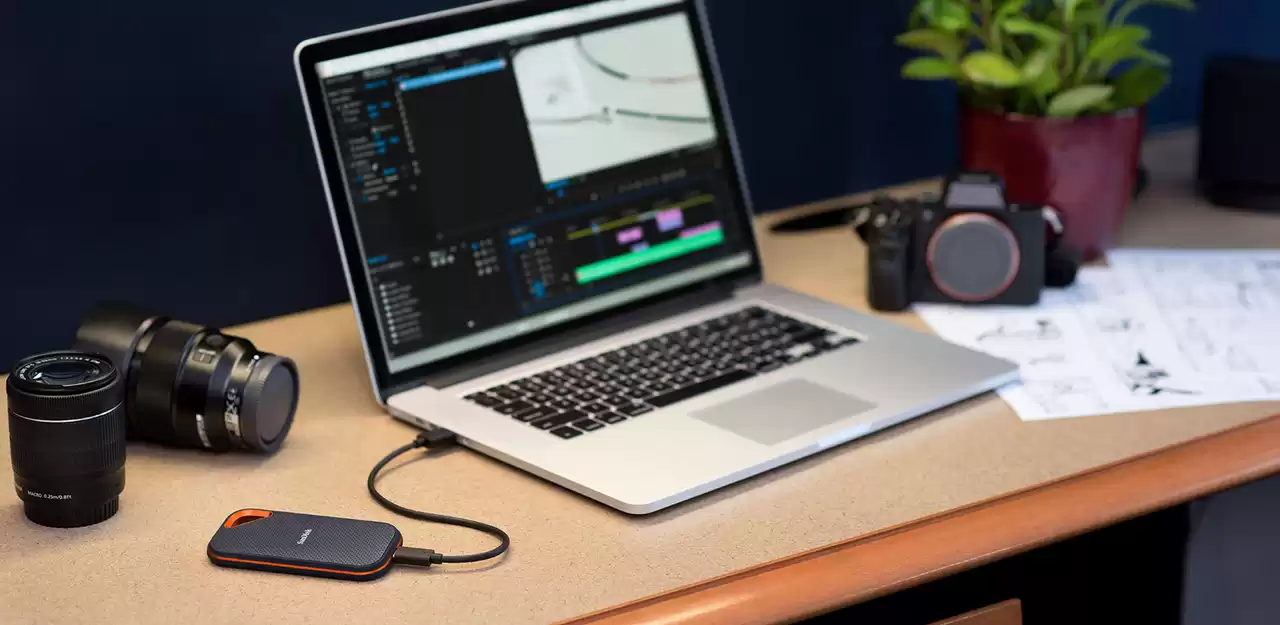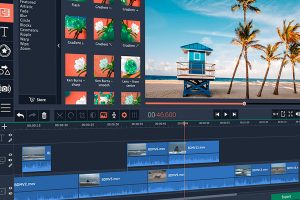The SanDisk Extreme Pro Portable V2 is an absolute dynamo, but is it for everybody?
Few portable SSDs on the market can reach the speeds of the SanDisk Extreme Pro Portable V2. The weather-resistant drive has a sporty, consumer-friendly look, though underneath the gray exterior lies cutting-edge technology so advanced that most modern hardware is incapable of accessing its full potential.
As the “Pro” version of SanDisk’s popular Extreme Portable SSD, this drive is faster, pricier, and designed specifically for a prosumer market assumed to have the most up-to-date tech. For videographers and photographers with cutting-edge PC, the Pro Portable V2 might be worth the money. For everyone else, though, it may be overkill.
What Is an NVMe SSD
With laptop storage being what it is these days, the importance of a high-capacity, ultra-fast portable storage solution cannot be understated. Solid State Drives (SSDs), which use flash memory chips rather than spinning disks to store and access data, are the best storage systems for on-the-go editing. Yet, within this style of storage drive, there are different formats that affect the storage size and speed of the drives. Out of these formats, there is one that stands above all others: non-volatile memory express (NVMe).

While we won’t dive too deep into the technical details of how NVMe drives work, it’s important to note that NVMe drives offer the fastest transfer speeds of any storage drives. NVMe drives, which use tiny NAND flash memory chips, are also very compact in comparison to standard SSDs and especially HDDs. Finally, NVMe drives are “non-volatile,” meaning that they can store data even when the drive loses power.
As with anything that’s best-in-class, NVMe drives are much more expensive than other storage drives. The Extreme Pro Portable V2 1TB retails for $300. These kinds of incredibly-fast drives are best for PC gamers, video and photo editors, and anyone else who needs access to lighting-fast transfer speeds.
The Reason You Shouldn’t Buy It
Aside from storage formats, there’s another aspect of storage drives that you should be familiar with: USB transfer standards. These USB transfer standards are set by the USB Implementers Forum — a group of 700 companies comprised of tech giants like Apple, Microsoft, and Intel — to ensure USB technology is the same across the industry. This group releases a new standard every few years, which allows for faster transfer speeds. Currently, USB 3.2 Gen 2 x2 is the fastest available USB standard, and it’s the one the Extreme Pro Portable V2 uses.
With this USB standard, SanDisk’s pro drive has a theoretical transfer speed of 20 Gbps, doubling the speed of the previous standard. While theoretical transfer speeds are just that, that transfer speed equates to transferring about 2.5 GB per second. That sounds amazing, and it is, but the problem is that almost no current hardware is compatible with this new standard yet.

PC users who want access to this kind of speed need to either upgrade their motherboard, which could cost around $300 or more. Alternatively, it’s possible to spend a fraction of that money to buy a 3.2 Gen 2×2 PCIe card to add a single USB-C header, though that’s assuming the CPU is compatible with the USB transfer standard.
Regardless, preparing your PC setup to be compatible with this drive is too expensive. The good news is that USB transfer standards are backward-compatible, meaning you can use the Extreme Pro Portable with any USB port. However, this limits the speed of the SSD to whatever the speed of the standard is. So if you have a USB 3.2 Gen 1 header, you’d only be able to access 5 Gbps transfer speeds rather than the full 20 Gbps.
Note for macOS users: You may have noticed that we didn’t mention anything about Apple computers, and that’s because Macs are not compatible with this new standard.
Affordable Alternatives to Sandisk Extreme Pro Portable V2
If the thought of spending a few hundred dollars to outfit your PC with the necessary hardware to make it compatible with the Extreme Pro Portable V2 is untenable, you’re not out of options when it comes to fast storage. Though you may not get 20 Gbps transfer speeds, you could opt for the more affordable Extreme Portable V2 SSD from Sandisk, which is capable of 10 Gbps transfer speeds at a fraction of the cost (about $85 for 1TB). Other external SSD options from trusted manufacturers like Samsung, Kingston, ADATA, and WD Black are also solid options.
Another route is to make your own external SSD by purchasing an NVMe SSD module and an SSD enclosure. This DIY method may save you some money, allowing you to make a custom storage solution that fits your needs. You don’t need to be tech-savvy, either. You screw in the SSD module inside the enclosure, and that’s basically it.
You Don’t Need it
The Extreme Pro Portable V2 is well-made, incredibly fast, and, unfortunately, way ahead of its time for most people. While you can still get decently fast transfer speeds thanks to the backward-compatible nature of USB standards, some drives offer 5 and even 10 Gbps transfer speeds for much less money. The review unit we tested, which was provided to us by Western Digital (the makers of SanDisk products), was great, but since we lack the tech to leverage the most out of the drive, it’s not likely we would have splurged on the Extreme Pro Portable V2.
If you’re a professional creator on the fence about buying this drive, it may be worth upgrading your setup due to the benefits offered by the drive. Faster transfer speeds mean less time waiting for files to load and more time editing content, so it can make sense financially, especially if you mark it down as a business expense. However, for everyone else, it’s best to wait until consumer hardware catches up.
Cover image via Western Digital.
Looking for filmmaking tips and tricks? Check out our YouTube channel for tutorials like this . . .




